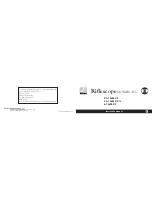
A
t
t
t
t
a
a
c
c
h
h
i
i
n
n
g
g
t
t
h
h
e
e
T
T
e
e
l
l
e
e
s
s
c
c
o
o
p
p
e
e
T
T
u
u
b
b
e
e
t
t
o
o
t
t
h
h
e
e
M
M
o
o
u
u
n
n
t
t
The telescope optical tube attaches to the altazimuth mount with the altitude slow motion rod assembly and the
respective knobs for the 60AZ, and 76AZ. The 50AZ attaches directly to the altazimuth mount head.
Before starting, remove the objective lens cap (refractor) or the front opening cap (Newtonian). To mount the
telescope tube to the mount for the 60AZ, and 76AZ:
1
Remove the protective paper covering the optical tube.
2
Put the telescope optical tube inside the yoke (altazimuth) mount so that the altitude slow motion rod
assembly is on the same side as the altitude locking screw (see Figure 1-1).
Note that on some telescopes
that the rod may be attached to the telescope optical tube. If the rod is not attached to the optical
tube, remove the screw from the mechanism (with the provided tool) shown on the far left of Figure
2-7 and put the rod in place as shown in Figure 2-7. Then, put the screw through the hole in the rod
and into the mechanism and tighten it.
3
Thread the altitude locking knob out so the hole is clear in the eyebolt (see Figure 2-8).
4
Put the rod of the assembly through the eyebolt and then tighten the altitude locking knob – Figure 2-9.
5
Thread the two knobs (one on either side of the mount) through the top of the mount into the threaded holes
in the optical tube and tighten – Figure 2-7.
Figure 2-7 Figure 2-8 Figure 2-9
For the 50AZ, take the following steps:
1.
Remove the protective paper covering the optical tube.
2.
Place the telescope optical tube on the altazimuth mount so that the hole in the top of the optical tube
platform lines up with the holes in the mount head – see Figure 2-11.
3.
Insert the altitude locking knob (see center of Figure 2-10) through the mount head and optical tube platform
(make sure the hole is clear all the way through before tightening the knob.
Figure 2-10 Figure 2-11
7


































